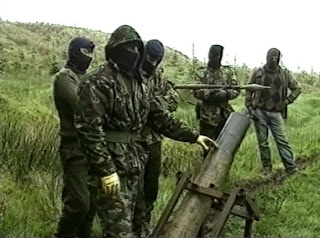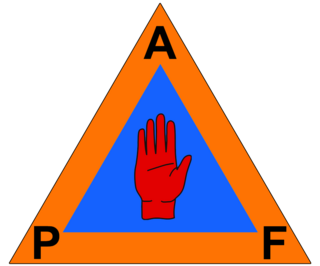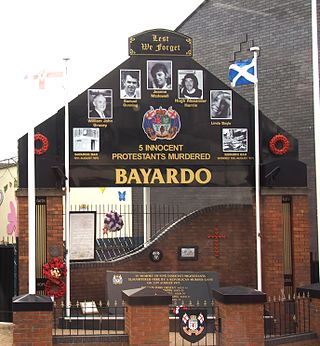Related Research Articles

The Troubles were an ethno-nationalist conflict in Northern Ireland that lasted for about 30 years from the late 1960s to 1998. Also known internationally as the Northern Ireland conflict, it is sometimes described as an "irregular war" or "low-level war". The conflict began in the late 1960s and is usually deemed to have ended with the Good Friday Agreement of 1998. Although the Troubles mostly took place in Northern Ireland, at times violence spilled over into parts of the Republic of Ireland, England, and mainland Europe.

The Ulster Volunteer Force (UVF) is an Ulster loyalist paramilitary group based in Northern Ireland. Formed in 1965, it first emerged in 1966. Its first leader was Gusty Spence, a former Royal Ulster Rifles soldier from Northern Ireland. The group undertook an armed campaign of almost thirty years during The Troubles. It declared a ceasefire in 1994 and officially ended its campaign in 2007, although some of its members have continued to engage in violence and criminal activities. The group is a proscribed organisation and is on the terrorist organisation list of the United Kingdom.

The Irish People's Liberation Organisation was a small Irish socialist republican paramilitary organisation formed in 1986 by disaffected and expelled members of the Irish National Liberation Army (INLA), whose factions coalesced in the aftermath of the supergrass trials. It developed a reputation for intra-republican and sectarian violence as well as criminality, before being forcibly disbanded by the Provisional Irish Republican Army (IRA) in 1992.
The Kingsmill massacre was a mass shooting that took place on 5 January 1976 near the village of Whitecross in south County Armagh, Northern Ireland. Gunmen stopped a minibus carrying eleven Protestant workmen, lined them up alongside it and shot them. Only one victim survived, despite having been shot 18 times. A Catholic man on the minibus was allowed to go free. A group calling itself the South Armagh Republican Action Force claimed responsibility. It said the shooting was retaliation for a string of attacks on Catholic civilians in the area by Loyalists, particularly the killing of six Catholics the night before. The Kingsmill massacre was the climax of a string of tit-for-tat killings in the area during the mid-1970s, and was one of the deadliest mass shootings of the Troubles.

From 1969 until 1997, the Provisional Irish Republican Army (IRA) conducted an armed paramilitary campaign primarily in Northern Ireland and England, aimed at ending British rule in Northern Ireland in order to create a united Ireland.
The Troubles in Keady refers to incidents taking place in Keady, County Armagh, Northern Ireland during the Troubles.
The South Armagh Republican Action Force(SARAF) shortened simply to the Republican Action Force(RAF) for a small number of attacks in Belfast was an Irish republican paramilitary group that was active from September 1975 to April 1977 during the Troubles in Northern Ireland. Its area of activity was mainly the southern part of County Armagh. According to writers such as Ed Moloney and Richard English, it was a cover name used by some members of the Provisional IRA South Armagh Brigade. The journalist Jack Holland, alleged that members of the Irish National Liberation Army (INLA) were also involved in the group. During the same time that the South Armagh Republican Action Force was active the INLA carried out at least one sectarian attack that killed Protestant civilians using the covername "Armagh People's Republican Army". According to Malcolm Sutton's database at CAIN, the South Armagh Republican Action Force was responsible for 24 deaths during the conflict, all of whom were classified as civilians.

The Protestant Action Force (PAF) was a front group used by Ulster loyalist paramilitaries in Northern Ireland when claiming responsibility for a number of attacks during the Troubles. First used in 1974, attacks by individuals claiming to be members of the PAF killed at least 41 Catholic civilians. The PAF was most commonly used by members of the Ulster Volunteer Force (UVF). All of the attacks claimed by the PAF in Armagh and Tyrone counties from 1974 to 1976 have been linked to the Glenanne gang, which was a group consisting of members of the UVF Mid-Ulster Brigade along with rogue Ulster Defence Regiment (UDR) soldiers and Royal Ulster Constabulary (RUC) police officers. A six-year period of no attacks claimed by the PAF ended in 1982; during the 1980s, the PAF claimed 15 attacks in the Belfast area and two in County Armagh. UDR soldiers were convicted of two attacks in Armagh. The PAF claimed its last attacks in the early 1990s, all of which were in north Armagh and were alleged to involve members of the security forces.
The Reavey and O'Dowd killings were two coordinated gun attacks on 4 January 1976 in County Armagh, Northern Ireland. Six Catholic civilians died after members of the Ulster Volunteer Force (UVF), an Ulster loyalist paramilitary group, broke into their homes and shot them. Three members of the Reavey family were shot at their home in Whitecross and four members of the O'Dowd family were shot at their home in Ballydougan. Two of the Reaveys and three of the O'Dowds were killed outright, with the third Reavey victim dying of brain haemorrhage almost a month later.
This is a timeline of actions by the Ulster Volunteer Force (UVF), an Ulster loyalist paramilitary group since 1966. It includes actions carried out by the Red Hand Commando (RHC), a group integrated into the UVF shortly after their formation in 1972. It also includes attacks claimed by the Protestant Action Force (PAF), a covername used by the UVF. Most of these actions took place during the conflict known as "the Troubles" in Northern Ireland.

The Tullyvallen massacre took place on 1 September 1975, when Irish republican gunmen attacked an Orange Order meeting hall at Tullyvallen, near Newtownhamilton in County Armagh, Northern Ireland. The Orange Order is an Ulster Protestant and unionist brotherhood. Five Orangemen were killed and seven wounded in the shooting. The "South Armagh Republican Action Force" claimed responsibility, saying it was retaliation for a string of attacks on Catholic civilians by Loyalists. It is believed members of the Provisional IRA carried out the attack, despite the organisation being on ceasefire.
UVF Mid-Ulster Brigade formed part of the loyalist paramilitary Ulster Volunteer Force in Northern Ireland. The brigade was established in Lurgan, County Armagh in 1972 by its first commander Billy Hanna. The unit operated mainly around the Lurgan and Portadown areas. Subsequent leaders of the brigade were Robin Jackson, known as "The Jackal", and Billy Wright. The Mid-Ulster Brigade carried out many attacks, mainly in Northern Ireland, especially in the South Armagh area, but it also extended its operational reach into the Republic of Ireland. Two of the most notorious attacks in the history of the Troubles were carried out by the Mid-Ulster Brigade: the 1974 Dublin and Monaghan bombings and the Miami Showband killings in 1975. Members of the Mid-Ulster Brigade were part of the Glenanne gang which the Pat Finucane Centre has since linked to at least 87 lethal attacks in the 1970s.

The Bayardo Bar attack took place on 13 August 1975 in Belfast, Northern Ireland. A unit of the Provisional Irish Republican Army (IRA), led by Brendan McFarlane, launched a bombing and shooting attack on a pub on Aberdeen Street, in the loyalist Shankill area. IRA members stated the pub was targeted because it was frequented by members of the Ulster Volunteer Force (UVF). Four Protestant civilians and one UVF member were killed, while more than fifty were injured.

The Hillcrest Bar bombing, also known as the "Saint Patrick's Day bombing", took place on 17 March 1976 in Dungannon, County Tyrone, Northern Ireland. The Ulster Volunteer Force (UVF), a loyalist paramilitary group, detonated a car bomb outside a pub crowded with people celebrating Saint Patrick's Day. Four Catholic civilians were killed by the blast—including two 13-year-old boys standing outside—and almost 50 people were injured, some severely.

The Darkley killings or Darkley massacre was a gun attack carried out on 20 November 1983 near the village of Darkley in County Armagh, Northern Ireland. Three gunmen attacked worshippers attending a church service at Mountain Lodge Pentecostal Church, killing three Protestant civilians and wounding seven. The attackers were members of the Irish National Liberation Army (INLA) acting on their own. They claimed responsibility using the cover name "Catholic Reaction Force", saying it was retaliation for recent sectarian attacks on Catholics by the loyalist "Protestant Action Force". The attack was condemned by the INLA leadership.
On 2 October 1975, the loyalist paramilitary group the Ulster Volunteer Force (UVF) carried out a wave of shootings and bombings across Northern Ireland. Six of the attacks left 12 people dead and around 45 people injured. There was also an attack in a small village in County Down called Killyleagh. There were five attacks in and around Belfast which left people dead. A bomb which exploded in Coleraine left four UVF members dead. There were also several other smaller bombs planted around Northern Ireland but other than causing damage they did not kill or injure anyone.
The Strand Bar Bombing was a bomb attack on a pub in Belfast, Northern Ireland on 12 April 1975, during the Troubles. The Ulster Volunteer Force (UVF), a loyalist paramilitary group, threw an improvised bomb into a pub frequented by Catholics in the Short Strand neighbourhood, killing six civilians and injuring about fifty others. It took place during a spate of tit-for-tat attacks by loyalists and Irish republican paramilitaries. The attack was claimed by the UVF unit known as the Red Hand Commando (RHC).

The Central Bar bombing was a bomb attack on a pub in the town of Gilford near Portadown in County Down in Northern Ireland on 31 December 1975. The attack was carried out by members of the Irish National Liberation Army (INLA) using the covername "People's Republican Army" although contemporary reports also said the "Armagh unit" of the "People's Republican Army" had claimed responsibility. Three Protestant civilians were killed in the bombing.
The Charlemont pub attacks were co-ordinated militant Loyalist paramilitary attacks on two pubs in the small village of Charlemont, County Armagh, Northern Ireland, carried out by the Ulster Volunteer Force (UVF) on the 15 May 1976. The attacks have been attributed to the Glenanne gang which was a coalition of right-wing Loyalist paramilitaries and subversive members inside the Royal Ulster Constabulary (RUC), the Ulster Defense Regiment (UDR) and the British Army.
References
- 1 2 3 "Cain - Sutton Index of Deaths - 29 July 1976". CAIN Archive - Conflict and Politics in Northern Ireland. CAIN. Retrieved 21 July 2022.
- ↑ Cadwallader, Anne (18 October 2013). Lethal Allies: British Collusion in Ireland (Paperback 1st ed.). Mercier Press. pp. 12–14. ISBN 978-1781171882.
- ↑ Taylor, Peter (1 March 1999). Behind the Mask: The Ira and Sinn Fein (Paperback ed.). TV Books Inc. pp. 218–220. ISBN 157500061X.
- ↑ "Wednesday 2 April 1975 proni on cain IRA Truce". CAIN Archive - Conflict and Politics in Northern Ireland. CAIN. Retrieved 21 July 2022.
- ↑ "Cain - Sutton Index of Deaths - 5 April 1975". CAIN Archive - Conflict and Politics in Northern Ireland. CAIN. Retrieved 21 July 2022.
- ↑ Tiernan, Joe (1 January 2004). The Dublin Bombings and the Murder Triangle (Paperback ed.). Mercier Press. ISBN 9781856353205.
- ↑ Cadwallader, Anne (18 October 2013). Lethal Allies: British Collusion in Ireland (Paperback, 1st ed.). Mercier Press. p. 145. ISBN 978-1781171882.
- ↑ "1976: Ten dead in Northern Ireland ambush". 5 January 1976. Retrieved 22 July 2022.
- ↑ Wharton, Ken (15 July 2013). Wasted Years, Wasted Lives Volume 1: The British Army in Northern Ireland: 1975 - 1977 (Hardcover ed.). .Helion and Company. ISBN 978-1909384552 . Retrieved 28 July 2022.
- ↑ "Stag Inn Shooting". EXTRAMURAL ACTIVITY LIFE IN BELFAST AS REPRESENTED ON ITS WALLS – MURALS, GRAFFITI, STREET ART. Extramural Activity. 10 March 2021. Retrieved 20 July 2022.
- ↑ "The Regimental Association of The Ulster Defence Regiment CGC: 1976". Ulster Defence Regiment Association. Retrieved 28 July 2022.
- ↑ "Cain - Sutton Index of Deaths - 31 July 1976". CAIN Archive - Conflict and Politics in Northern Ireland. CAIN. Retrieved 28 July 2022.
- ↑ "Cain - Sutton Index of Deaths - 2 April 1977". CAIN Archive - Conflict and Politics in Northern Ireland. CAIN. Retrieved 21 July 2022.
- ↑ "Cain - Sutton Index of Deaths - 21 April 1977". CAIN Archive - Conflict and Politics in Northern Ireland. CAIN. Retrieved 21 July 2022.
- ↑ Taylor, Peter (1 March 1999). Behind the Mask: The Ira and Sinn Fein (Paperback ed.). TV Books Inc. p. 229. ISBN 157500061X.
- ↑ "Lethal Allies: how two families fought for the truth" . Retrieved 21 July 2022.